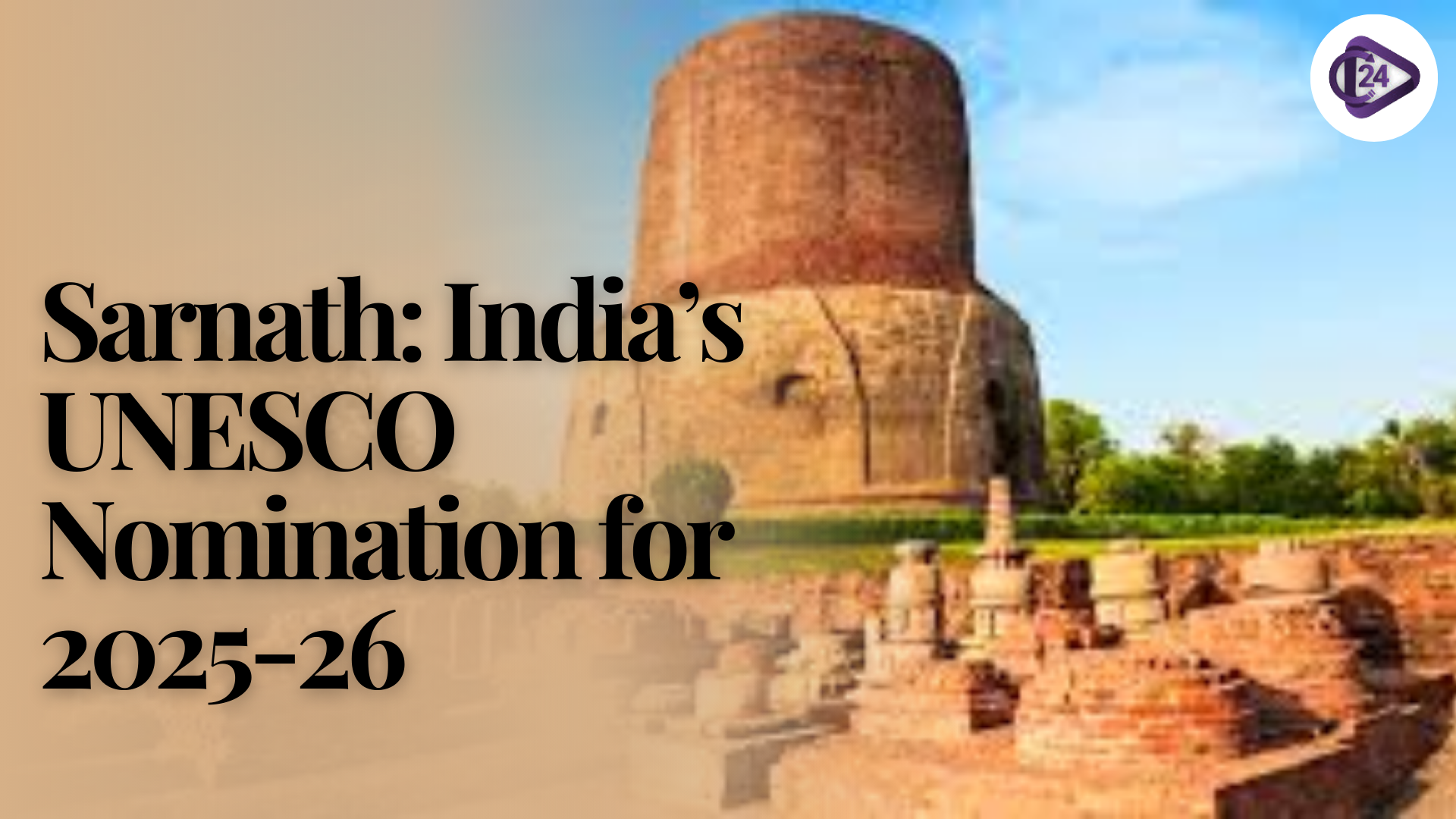
India has officially nominated Sarnath for inclusion in the UNESCO World Heritage List for the 2025-26 cycle, ending a 27-year wait on the tentative list. The Archaeological Survey of India (ASI) will also install a corrected plaque crediting Babu Jagat Singh (1787-88), a local ruler, for the rediscovery of the site, rather than the British, ahead of the UNESCO team’s visit.
About Sarnath
-
Historical and Religious Significance:
-
Buddhist Pilgrimage Site: Sarnath is one of the most important Buddhist pilgrimage destinations in the world. It is the site where Gautama Buddha delivered his first sermon around 528 BCE, marking the beginning of his teachings on the Middle Way and the Four Noble Truths.
-
Formation of the Buddhist Sangha: It is also where the Buddhist Sangha (community) was first formed.
-
Ancient Names: Sarnath was historically known as Mrigadava (Deer Park) or Rishipatana.
-
-
Monuments and Contributions:
-
Emperor Ashoka's Lion Capital Pillar: Emperor Ashoka (268-232 BCE) erected the famous Lion Capital Pillar at Sarnath, which now serves as India's national emblem. He also commissioned significant monastic structures, including the Dhamek Stupa, marking the spot where Buddha delivered his first sermon.
-
Patronage by Later Dynasties: The Kushanas (1st-4th century CE) and Guptas (3rd-6th century CE) continued to expand and patronize the site, ensuring its prominence.
-
-
Decline and Destruction:
-
12th Century CE Decline: Sarnath flourished as a monastic center until the 12th century CE, after which it was destroyed and abandoned due to invasions by Qutb-ud-din Aibak (1193 CE) during Muhammad Ghor’s campaign. This resulted in the sacking of temples and monasteries, marking the beginning of its decline.
-
13th Century Ruins: By the 13th century, Sarnath lay in ruins, coinciding with the overall decline of Buddhism in India.
-
-
Rediscovery and Modern Excavations:
-
Rediscovery in 1787-88: The site was rediscovered when workers under Jagat Singh, Diwan of Raja Chait Singh of Benares, unearthed Buddhist relics while digging for construction materials.
-
1799 Attention: The site gained wider attention in 1799 after Jonathan Duncan, an indologist and founder of the Sanskrit College at Varanasi, described the discoveries in his writings, spurring further interest among British scholars.
-
Excavations by Alexander Cunningham (1835-36): The Archaeological Survey of India (ASI), founded by Alexander Cunningham, carried out excavations that confirmed Sarnath as the site of Buddha’s first sermon.
-
1904-05 Excavations: The most significant excavations took place in 1904-05, unearthing over 470 relics and 41 inscriptions, which shaped the site's archaeological identity.
-
-
Contemporary Significance:
-
Pilgrimage Site: Sarnath is now regarded as one of the four holiest Buddhist pilgrimage sites, alongside Lumbini, Bodh Gaya, and Kushinagara.
-
Visitor Data: According to ASI, over 8.43 lakh visitors visited Sarnath in 2024-25, showcasing its continued global significance.
-
-
UNESCO Nomination:
-
India’s nomination of Sarnath to the UNESCO World Heritage List underscores the country's commitment to preserving and promoting its Buddhist heritage on the world stage. The inclusion would further elevate Sarnath's status as a major global pilgrimage and cultural site.
-
Significance of the Nomination:
-
Cultural Heritage Preservation: The UNESCO nomination of Sarnath is a step toward ensuring the preservation of the site’s rich Buddhist heritage and making it accessible to a global audience.
-
Tourism & Awareness: Being recognized by UNESCO will enhance Sarnath’s international reputation, attracting more pilgrims and tourists, contributing to the cultural exchange and promoting historical education.
Conclusion
India’s nomination of Sarnath for the UNESCO World Heritage List is a monumental step in preserving the country’s Buddhist heritage. The site's historical and religious significance, coupled with its modern-day role as a global pilgrimage destination, makes it a fitting candidate for global recognition. This move not only honors the legacy of Gautama Buddha and his teachings but also promotes cultural tourism and historical education, ensuring that Sarnath remains a key landmark in India’s rich heritage. The inclusion of Sarnath in the UNESCO list will enhance India's efforts to protect and showcase its ancient traditions on the world stage, making it an essential part of global cultural heritage.



 System for Pension Administration – Raksha (SPARSH)
System for Pension Administration – Raksha (SPARSH) Election Commission Delists 474 Unrecognised Political Parties
Election Commission Delists 474 Unrecognised Political Parties Clean Plant Programme: India’s Step Towards Disease-Free Horticulture
Clean Plant Programme: India’s Step Towards Disease-Free Horticulture Sign Language Day 2025: ISLRTC Launches Key Initiatives for Deaf Inclusion
Sign Language Day 2025: ISLRTC Launches Key Initiatives for Deaf Inclusion Surajpur Achieves Milestone: 75 Villages Declared Child Marriage-Free
Surajpur Achieves Milestone: 75 Villages Declared Child Marriage-Free Modi to Dedicate Dhordo as India’s Newest Solar Village
Modi to Dedicate Dhordo as India’s Newest Solar Village India Adds Seven Natural Heritage Sites to UNESCO’s Tentative List
India Adds Seven Natural Heritage Sites to UNESCO’s Tentative List MNRE Unveils India’s First National Policy on Geothermal Energy
MNRE Unveils India’s First National Policy on Geothermal Energy Raj Gond Tribe Rehearses for Gussadi Dance at Hyderabad Liberation Day
Raj Gond Tribe Rehearses for Gussadi Dance at Hyderabad Liberation Day






